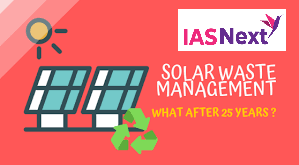CURRENT AFFAIRS
Get the most updated and recent current affair content on Padhaikaro.com
Solar waste handling policy
- IAS NEXT, Lucknow
- 18, Feb 2022

Reference News:-
The International Renewable Energy Agency (IRENA) has estimated that the global photovoltaic waste will touch 78 million tonnes by 2050.
- India is expected to be one of the top five generators of such waste.
Key takeaways
- While India is increasing its solar power capacity, it does not yet have a firm policy on managing waste that results from used solar panels or from the manufacturing process.
- India currently considers solar waste a part of electronic waste and does not account for it separately.
- Also, There is no commercial raw material recovery facility for solar e-waste operational in India.
- But a pilot facility for solar panel recycling and material recovery had been set up by a private company in Gummidipoondi in Tamil Nadu.
Solar Energy in India
- India has set a target of producing 100 GW of solar energy by 2022.
- India’s Intended Nationally Determined Contributions (INDC’s) commitment includes 100 GW of solar power out of 175 GW of renewable energy by 2022.
- Ministry of New and Renewable energy is the nodal agency to tackle India’s renewable energy issues.
- National Solar Mission aims to establish India as a global leader in solar energy by creating the policy conditions for its deployment across the country.
- Rooftop Solar Scheme: To generate solar power by installing solar panels on the roof of the houses
- Production-linked Incentive (PLI) scheme to promote manufacturing of high efficiency solar PV modules in India.
- International Solar Alliance (ISA): Launched by the Indian Prime Minister and the French President in 2015 with a vision to enable One World, One Sun, One Grid (OSOWOG).
- One Sun, One World, One Grid (OSOWOG): A framework for facilitating global cooperation, building a global ecosystem of interconnected renewable energy resources (mainly solar energy) that can be smoothly shared.
Do you know?
- The cumulative capacity of grid-connected solar photovoltaic (PV) installations is around 40 GW.
- The capacity of about 35.6 GW is generated from ground-mounted plants and 4.4 GW from rooftop solar.
- A gigawatt is a 1,000 megawatt.
- Solar Photovoltaic: Solar photovoltaic (SPV) cells convert solar radiation (sunlight) into electricity. A solar cell is a semi-conducting device made of silicon and/or other materials, which, when exposed to sunlight, generates electricity